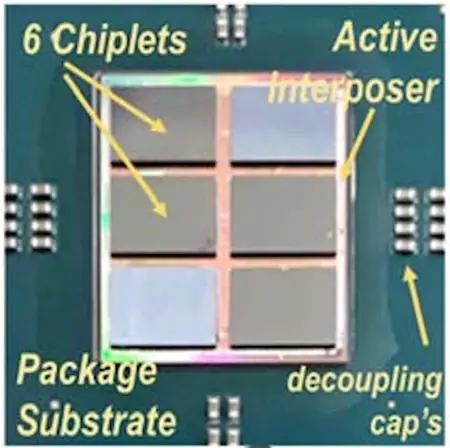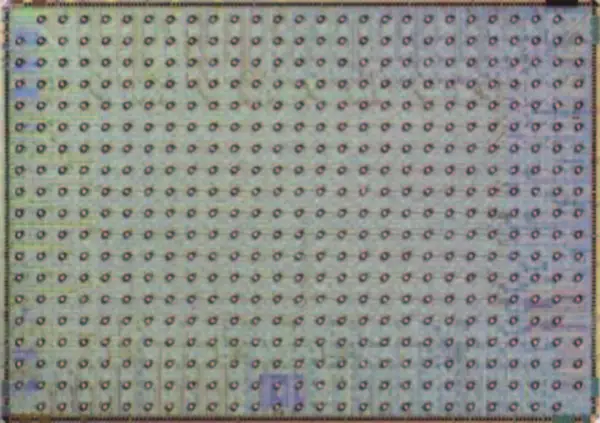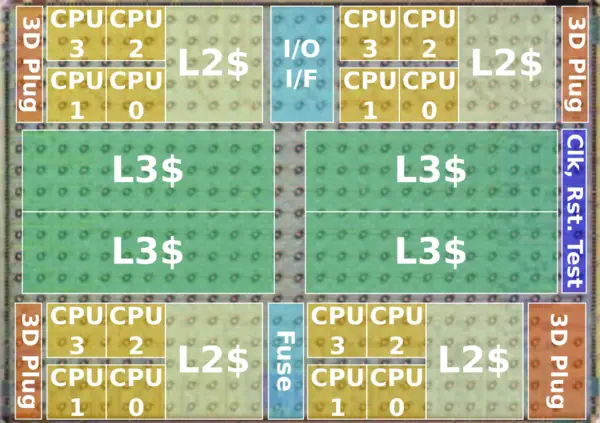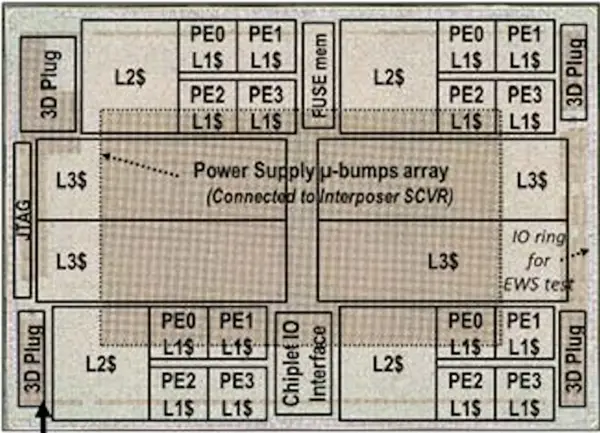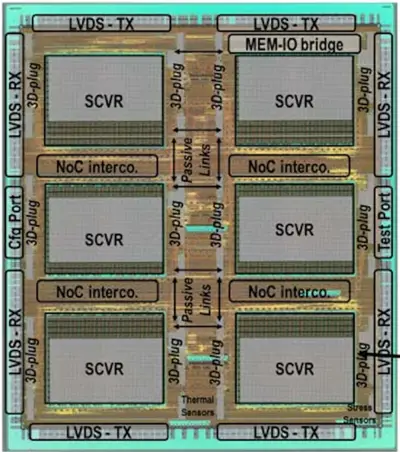From WikiChip
Difference between revisions of "cea-leti/microarchitectures/tsarlet"
(→Compute chiplet) |
(→Die) |
||
| Line 33: | Line 33: | ||
== Overview == | == Overview == | ||
{{empty section}} | {{empty section}} | ||
| + | |||
| + | == Package == | ||
| + | * BGA-1517 | ||
| + | * 39 x 39, 40 mm x 40 mm, 10 layers | ||
| + | ** 1517 balls | ||
| + | ** 500 µm, 1 mm pitch | ||
| + | |||
| + | |||
| + | :[[File:tsarlet package.png|450px]] | ||
== Die == | == Die == | ||
=== Compute chiplet === | === Compute chiplet === | ||
* [[STMicroelectronics]] [[28 nm]] [[FDSOI]] | * [[STMicroelectronics]] [[28 nm]] [[FDSOI]] | ||
| − | ** 10 metal layers | + | ** 10 metal layers, 0.5-1.3V + adaptive biasing |
| − | * 4 mm x 5.6 mm (22 mm²) silicon area | + | * 4 mm x 5.6 mm (22.4 mm²) silicon area |
* 395,000,000 transistors | * 395,000,000 transistors | ||
* I/O | * I/O | ||
| Line 53: | Line 62: | ||
:[[File:tsarlet compute chiplet (annotated).png|600px]] | :[[File:tsarlet compute chiplet (annotated).png|600px]] | ||
| + | |||
| + | :[[File:tsarlet compute chiplet 2.png|600px]] | ||
=== Base interposer die === | === Base interposer die === | ||
| + | * [[65 nm process]] | ||
| + | ** 7 metal layers, MIM option, 1.2 V | ||
| + | * 13.05 mm x 15.16 mm (197.8 mm²) silicon area | ||
| + | * I/O | ||
| + | ** 150,000 μ-bumps, 20 μm pitch | ||
| + | *** 20,000 signal, 120,000 power + 10,000 dummies | ||
| + | ** 14,000 TSV middle, 40 μm pitch | ||
| + | *** 2,000 signal, 12,000 power | ||
| + | |||
| + | :[[File:tsarlet base interposer.png|400px]] | ||
Revision as of 03:31, 29 February 2020
| Edit Values | |
| TSARLET µarch | |
| General Info | |
| Arch Type | CPU |
| Designer | CEA-Leti |
| Manufacturer | STMicroelectronics |
| Process | 28 nm, 65 nm |
| Core Configs | 96 |
| Pipeline | |
| Type | Scalar, Single-issue |
| OoOE | No |
| Speculative | No |
| Reg Renaming | No |
| Stages | 5 |
| Decode | 1-way |
| Instructions | |
| ISA | MIPS32v1 |
| Cache | |
| L1I Cache | 16 KiB/core |
| L1D Cache | 16 KiB/core |
| L2 Cache | 256 KiB/core |
| L3 Cache | 1 MiB/core |
TSARLET was a research microarchitecture designed by CEA-Leti demonstarting the theoretical capabilities of a large-scale high-performance 3D stacked chiplets-based SoC technology. The project comprised 96 MIPS cores built using 6 chiplets 3D stack on an active interposer in order to demonstarte in-package silicon scale-out capabilities with superior inter-chip capabilities while reducing the overall power and production cost.
Contents
Architecture
Memory Hierarchy
| This section is empty; you can help add the missing info by editing this page. |
Overview
| This section is empty; you can help add the missing info by editing this page. |
Package
- BGA-1517
- 39 x 39, 40 mm x 40 mm, 10 layers
- 1517 balls
- 500 µm, 1 mm pitch
Die
Compute chiplet
- STMicroelectronics 28 nm FDSOI
- 10 metal layers, 0.5-1.3V + adaptive biasing
- 4 mm x 5.6 mm (22.4 mm²) silicon area
- 395,000,000 transistors
- I/O
- 2D
- 249 signal, 237 power
- C4 bumps, 200 µm pitch
- 3D
- 2618 signal
- up to metal 10 @ 20 µm pitch
- 2D
Base interposer die
- 65 nm process
- 7 metal layers, MIM option, 1.2 V
- 13.05 mm x 15.16 mm (197.8 mm²) silicon area
- I/O
- 150,000 μ-bumps, 20 μm pitch
- 20,000 signal, 120,000 power + 10,000 dummies
- 14,000 TSV middle, 40 μm pitch
- 2,000 signal, 12,000 power
- 150,000 μ-bumps, 20 μm pitch
Facts about "TSARLET - Microarchitectures - CEA Leti"
| codename | TSARLET + |
| core count | 96 + |
| designer | CEA-Leti + |
| full page name | cea-leti/microarchitectures/tsarlet + |
| instance of | microarchitecture + |
| instruction set architecture | MIPS32v1 + |
| manufacturer | STMicroelectronics + |
| microarchitecture type | CPU + |
| name | TSARLET + |
| pipeline stages | 5 + |
| process | 28 nm (0.028 μm, 2.8e-5 mm) + and 65 nm (0.065 μm, 6.5e-5 mm) + |
